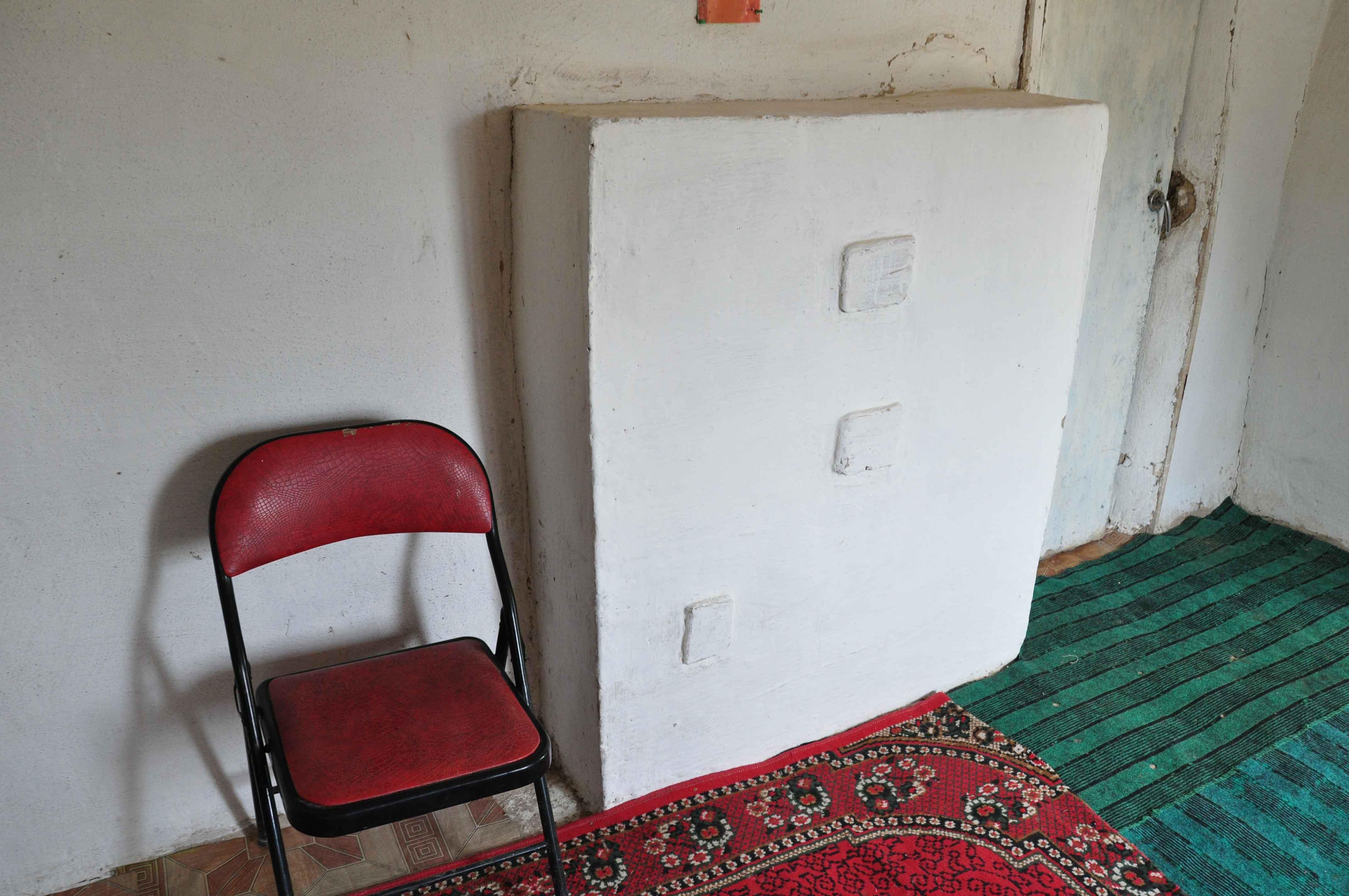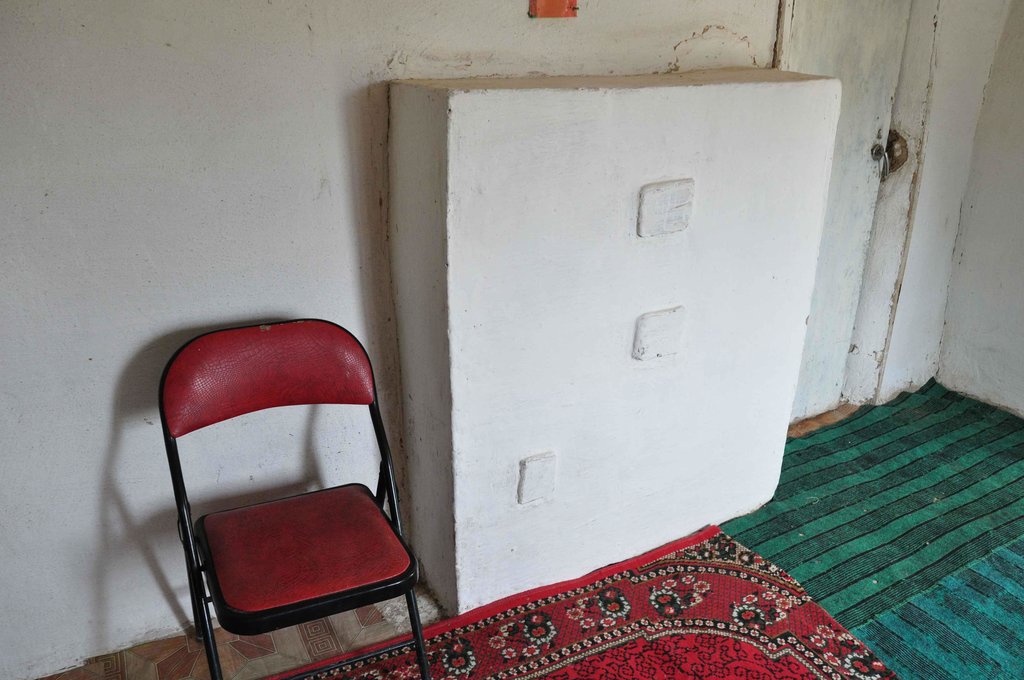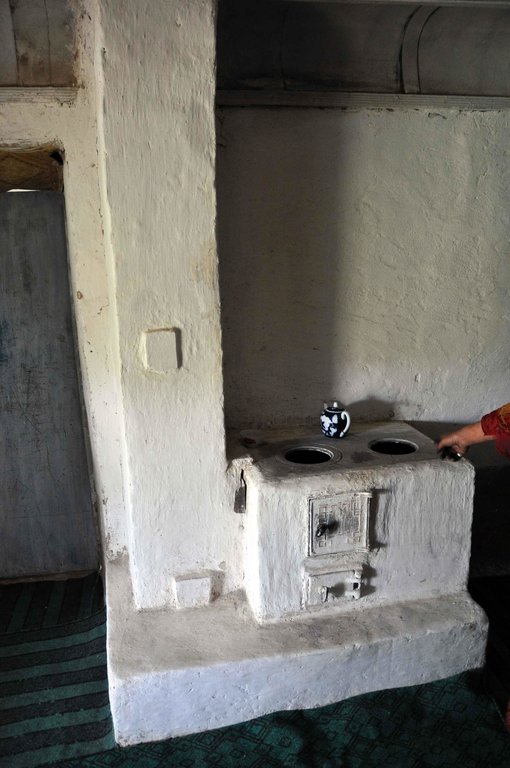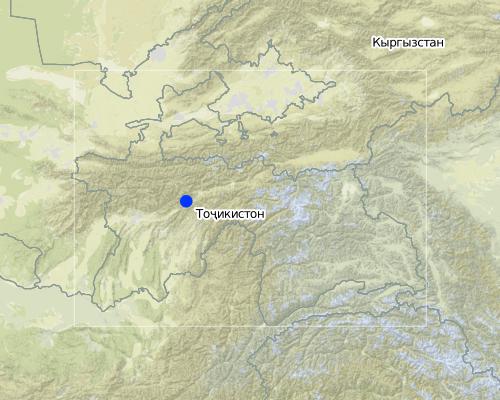Two Room Stove [Tadjikistan]
- Création :
- Mise à jour :
- Compilateur : shane stevenson
- Rédacteur : –
- Examinateur : David Streiff
technologies_1518 - Tadjikistan
Voir les sections
Développer tout Réduire tout1. Informations générales
1.2 Coordonnées des personnes-ressources et des institutions impliquées dans l'évaluation et la documentation de la Technologie
Spécialiste GDT:
Pochoev Mirzokurbon
mirzo_pochoev@camp.tojikiston.com
CAMP
Tadjikistan
Nom du ou des institutions qui ont facilité la documentation/ l'évaluation de la Technologie (si pertinent)
CAMP - Central Asian Mountain Partnership (CAMP - Central Asian Mountain Partnership) - Kirghizistan1.3 Conditions relatives à l'utilisation par WOCAT des données documentées
Quand les données ont-elles été compilées (sur le terrain)?
11/07/2011
Le compilateur et la(les) personne(s) ressource(s) acceptent les conditions relatives à l'utilisation par WOCAT des données documentées:
Oui
2. Description de la Technologie de GDT
2.1 Courte description de la Technologie
Définition de la Technologie:
A brick stove that is built into the existing internal wall, that will heat the two rooms and can be used for cooking.
2.2 Description détaillée de la Technologie
Description:
The 2-room stove is a brick based structure that filters hot air into a second room, hence maximising the heating potential of the fuel. The basic stove is built of fire bricks, house bricks, cement and coated with a natural mix of straw and mud. It is a traditional concept based upon former soviet stoves, that was modernised and adapted to improve the energy efficiency, and make use of the materials that are available to the people. It is able to burn coal, wood, and tapac, and is designed to reduce the amount of natural resources used to meet the household energy needs.
Purpose of the Technology: The purpose of the 2-room stove is to replace the traditional cast iron pig style of stove, with a more modern and energy efficient stove that can be used effectively for cooking and the heating of two rooms. The 2-room stove is designed to filter the hot air between the rooms and the use the bricks as a thermal sink for heat retention. As most of the houses are made of mud bricks, the heat from the stove will conduct through the walls, which will act as radiators to emit warmth into the room. The 2-room stove also means that cooking activities can be conducted inside the house in a smoke free environment.
Establishment / maintenance activities and inputs: The stove requires basic training in construction by a skilled technician, however after a three day training course the local trades people are able to build their own stoves with limited supervision. The stove is constructed from 45 fire bricks and 400 household bricks, the hot plate and stove doors are bought second hand from the markets, and metal bars are used to reinforce the structure. There are two smoke vents in the wall between the two rooms to allow the smoke to filter its way along the snake like chimney until it vents through the roof. The final structure is coated in straw and mud which acts as an insulation layer.
Natural / human environment: There is a high reliance on natural resources in Shahtuti Bolo. The average family burns several tons of tapac (straw dung mix) and wood each year. The surrounding mountain area is sparsely vegetated and does not even provide enough fuel for the village during the harsh winter months. This is supplemented by buying wood from the neighbouring villages. One tapac weighs one kilo, this is organic matter that can no longer be used for soil enhancement, but for fuel purposes. It is estimated that the 2-room stove will reduce the amount of fuel burnt by 20-40% depending upon the household.
2.3 Photos de la Technologie
2.5 Pays/ région/ lieux où la Technologie a été appliquée et qui sont couverts par cette évaluation
Pays:
Tadjikistan
Région/ Etat/ Province:
Hakimi Jamoat, Nurobod
Autres spécifications du lieu:
Regional Subordination of Tajikistan
Map
×2.6 Date de mise en œuvre de la Technologie
Si l'année précise est inconnue, indiquez la date approximative: :
- il y a moins de 10 ans (récemment)
2.7 Introduction de la Technologie
Spécifiez comment la Technologie a été introduite: :
- par le biais de projets/ d'interventions extérieures
Commentaires (type de projet, etc.) :
The two room stove is modernisation of a traditional design, therefore the concept is not new to the people.
3. Classification de la Technologie de GDT
3.1 Principal(aux) objectif(s) de la Technologie
- reduce energy
3.2 Type(s) actuel(s) d'utilisation des terres, là où la Technologie est appliquée

Pâturages

Implantations, infrastructures
- Habitats, buildings
Remarques:
The technology is implemented in the households
Commentaires:
Major land use problems (compiler’s opinion): The over exploitation of natural resources that have lead to soil erosion and degradation of the soil structure.
Major land use problems (land users’ perception): The land has become increasingly unproductive over the last few decades. There is not enough pasture to feed our animals.
Constraints of settlement / urban
3.3 Informations complémentaires sur l'utilisation des terres
Précisez:
Longest growing period in days: 180Longest growing period from month to month: April - October
3.4 Groupe de GDT auquel appartient la Technologie
- technologies d'efficacité énergétique
3.5 Diffusion de la Technologie
Spécifiez la diffusion de la Technologie:
- répartie uniformément sur une zone
Si la Technologie est uniformément répartie sur une zone, indiquez la superficie couverte approximative:
- 0,1-1 km2
Commentaires:
The village of Shahtuti Bolo
3.6 Mesures de GDT constituant la Technologie

structures physiques
- S11: Autres
Commentaires:
Main measures: structural measures
3.7 Principaux types de dégradation des terres traités par la Technologie

érosion hydrique des sols
- Wt: perte de la couche superficielle des sols (couche arable)/ érosion de surface
- Wg: ravinement/ érosion en ravines
- Wm: mouvements de masse/ glissements de terrain

érosion éolienne des sols
- Et: perte de la couche superficielle des sols (couche arable)

dégradation chimique des sols
- Cn: baisse de la fertilité des sols et réduction du niveau de matière organique (non causée par l’érosion)

dégradation biologique
- Bc: réduction de la couverture végétale
- Bh: perte d’habitats
- Bq: baisse de la quantité/ biomasse
Commentaires:
Main type of degradation addressed: Wt: loss of topsoil / surface erosion, Wg: gully erosion / gullying, Wm: mass movements / landslides, Et: loss of topsoil, Cn: fertility decline and reduced organic matter content, Bc: reduction of vegetation cover, Bh: loss of habitats
Secondary types of degradation addressed: Bq: quantity / biomass decline
Main causes of degradation: soil management (Failure to use organic fertilisers), deforestation / removal of natural vegetation (incl. forest fires) (Removal of natural resources to meet local energy needs.), over-exploitation of vegetation for domestic use (as above), overgrazing (Areas became over grazed as productivity declined), disturbance of water cycle (infiltration / runoff) (removal of vegetation leads to increased run off from the mountain slopes.), poverty / wealth (There is a lack of money for investment), labour availability (Two thirds of the households in the village have people working abroad.), war and conflicts (There has been substantial political unrest in the area.)
Secondary causes of degradation: Heavy / extreme rainfall (intensity/amounts) (There is a perception that there are more extreme rainfall events.), population pressure (Popualtion in the area is increasing), education, access to knowledge and support services (Lack of knowledge on good land management.)
3.8 Prévention, réduction de la dégradation ou réhabilitation des terres dégradées
Spécifiez l'objectif de la Technologie au regard de la dégradation des terres:
- prévenir la dégradation des terres
- réduire la dégradation des terres
Commentaires:
Main goals: mitigation / reduction of land degradation
Secondary goals: prevention of land degradation
4. Spécifications techniques, activités, intrants et coûts de mise en œuvre
4.1 Dessin technique de la Technologie
Auteur:
S. stevenson, CAMP Kuhiston, apt19 h 131 Rudaki ave, 734003, Dushanbe
4.2 Spécification/ explications techniques du dessin technique
A simple view of the main part of the stove used for cooking. There are two cast iron doors, the lower is for air circulation and the upper is the combustion chamber for the fuel. There are two hot plates for cooking. The smoke travels from the fire vent towards the chimney and then through a 10cm sq hole to the brick structure on the other side. The smoke snakes it way around the the second structure which acts as a radiator as the bricks warm up. The smoke then returns into the chimney in the main room, heating the chimney as it vents.
Location: Shahtuti Bolo. Nurobod
Date: 13.07.2011
Technical knowledge required for field staff / advisors: high (The technical design requires a high level of knowledge)
Technical knowledge required for land users: moderate (With training the land user would be able to build their own two room stove)
Main technical functions: reduces the amount of dung and wood used as fuel.
Structural measure: 2-room stove
Construction material (other): fire bricks and regular house bricks, covered in mud are the main materials.
4.3 Informations générales sur le calcul des intrants et des coûts
Spécifiez la manière dont les coûts et les intrants ont été calculés:
- par entité de la Technologie
Précisez l'unité:
Stove
Indiquez la monnaie utilisée pour le calcul des coûts:
- dollars US
Indiquez le coût salarial moyen de la main d'œuvre par jour:
4.00
4.4 Activités de mise en place/ d'établissement
| Activité | Type de mesures | Calendrier | |
|---|---|---|---|
| 1. | Construction of stove | Structurel | any |
| 2. | None | None |
4.5 Coûts et intrants nécessaires à la mise en place
| Spécifiez les intrants | Unité | Quantité | Coûts par unité | Coût total par intrant | % des coût supporté par les exploitants des terres | |
|---|---|---|---|---|---|---|
| Main d'œuvre | Construction of stove | Persons/day | 6,0 | 5,333333 | 32,0 | 100,0 |
| Equipements | Tools | pieces | 5,0 | 4,0 | 20,0 | |
| Matériaux de construction | Bricks | bricks | 400,0 | 0,225 | 90,0 | |
| Matériaux de construction | Fire bricks | bricks | 45,0 | 1,4 | 63,0 | |
| Matériaux de construction | Metal bar | bars | 5,0 | 3,4 | 17,0 | |
| Matériaux de construction | Fire cement | cub m | 3,0 | 8,333333 | 25,0 | |
| Matériaux de construction | Ceramic tiles | tiles | 24,0 | 1,0 | 24,0 | |
| Matériaux de construction | Metal cooking plates | plates | 1,0 | 63,0 | 63,0 | |
| Matériaux de construction | Stove doors | doors | 2,0 | 22,5 | 45,0 | |
| Autre | Transports | vans | 1,0 | 50,0 | 50,0 | |
| Coût total de mise en place de la Technologie | 429,0 | |||||
Commentaires:
Duration of establishment phase: 1 month(s)
4.6 Activités d'entretien/ récurrentes
| Activité | Type de mesures | Calendrier/ fréquence | |
|---|---|---|---|
| 1. | Cleaning the stove | Structurel | annually |
4.7 Coûts et intrants nécessaires aux activités d'entretien/ récurrentes (par an)
| Spécifiez les intrants | Unité | Quantité | Coûts par unité | Coût total par intrant | % des coût supporté par les exploitants des terres | |
|---|---|---|---|---|---|---|
| Main d'œuvre | Cleaning the stove | Persons/day | 1,0 | 4,0 | 4,0 | 100,0 |
| Coût total d'entretien de la Technologie | 4,0 | |||||
Commentaires:
The costs are based upon 2011 prices and are based on constructing only one stove.
4.8 Facteurs les plus importants affectant les coûts
Décrivez les facteurs les plus importants affectant les coûts :
The main cost is the fire bricks. These have to be transported from the capital. However, in some regions of Tajikistan, materials are available from stoves that were constructed several decades ago which could be reused.
5. Environnement naturel et humain
5.1 Climat
Précipitations annuelles
- < 250 mm
- 251-500 mm
- 501-750 mm
- 751-1000 mm
- 1001-1500 mm
- 1501-2000 mm
- 2001-3000 mm
- 3001-4000 mm
- > 4000 mm
Zone agro-climatique
- semi-aride
Thermal climate class: temperate
5.2 Topographie
Pentes moyennes:
- plat (0-2 %)
- faible (3-5%)
- modéré (6-10%)
- onduleux (11-15%)
- vallonné (16-30%)
- raide (31-60%)
- très raide (>60%)
Reliefs:
- plateaux/ plaines
- crêtes
- flancs/ pentes de montagne
- flancs/ pentes de colline
- piémonts/ glacis (bas de pente)
- fonds de vallée/bas-fonds
Zones altitudinales:
- 0-100 m
- 101-500 m
- 501-1000 m
- 1001-1500 m
- 1501-2000 m
- 2001-2500 m
- 2501-3000 m
- 3001-4000 m
- > 4000 m
Indiquez si la Technologie est spécifiquement appliquée dans des:
- non pertinent
5.3 Sols
Profondeur moyenne du sol:
- très superficiel (0-20 cm)
- superficiel (21-50 cm)
- modérément profond (51-80 cm)
- profond (81-120 cm)
- très profond (>120 cm)
Texture du sol (de la couche arable):
- grossier/ léger (sablonneux)
Matière organique de la couche arable:
- faible (<1%)
Si disponible, joignez une description complète du sol ou précisez les informations disponibles, par ex., type de sol, pH/ acidité du sol, capacité d'échange cationique, azote, salinité, etc.
Soil fertility is low - medium
Soil drainage / infiltration is poor
Soil water storage capacity is low-medium
5.4 Disponibilité et qualité de l'eau
Profondeur estimée de l’eau dans le sol:
< 5 m
Disponibilité de l’eau de surface:
faible/ absente
Qualité de l’eau (non traitée):
faiblement potable (traitement nécessaire)
Commentaires et précisions supplémentaires sur la qualité et la quantité d'eau:
Availability of surface water: is good for the village because there is a stream and medium for other areas which have access to te stream.
5.5 Biodiversité
Diversité des espèces:
- faible
5.6 Caractéristiques des exploitants des terres appliquant la Technologie
Revenus hors exploitation:
- 10-50% de tous les revenus
Niveau relatif de richesse:
- très pauvre
- pauvre
Individus ou groupes:
- individu/ ménage
Genre:
- femmes
- hommes
Indiquez toute autre caractéristique pertinente des exploitants des terres:
Land users applying the Technology are mainly disadvantaged land users
Difference in the involvement of women and men: Training is provided on he construction of the stove. This is only attended by men.
Population density: 50-100 persons/km2
Annual population growth: 2% - 3%
80% of the land users are poor and own 95% of the land.
20% of the land users are poor and own 5% of the land.
Off-farm income specification: 44 out of the 58 households are reliant on remittances from Russia, however all the families have livestock which they buy and sell in the local markets and a small household plot for vegetables.
5.7 Superficie moyenne des terres détenues ou louées par les exploitants appliquant la Technologie
- < 0,5 ha
- 0,5-1 ha
- 1-2 ha
- 2-5 ha
- 5-15 ha
- 15-50 ha
- 50-100 ha
- 100-500 ha
- 500-1 000 ha
- 1 000-10 000 ha
- > 10 000 ha
Cette superficie est-elle considérée comme de petite, moyenne ou grande dimension (en se référant au contexte local)?
- petite dimension
5.8 Propriété foncière, droits d’utilisation des terres et de l'eau
Propriété foncière:
- état
Droits d’utilisation des terres:
- communautaire (organisé)
Commentaires:
Four people have the majority of the land user rights in a village of 58.
5.9 Accès aux services et aux infrastructures
santé:
- pauvre
- modéré
- bonne
éducation:
- pauvre
- modéré
- bonne
assistance technique:
- pauvre
- modéré
- bonne
emploi (par ex. hors exploitation):
- pauvre
- modéré
- bonne
marchés:
- pauvre
- modéré
- bonne
énergie:
- pauvre
- modéré
- bonne
routes et transports:
- pauvre
- modéré
- bonne
eau potable et assainissement:
- pauvre
- modéré
- bonne
services financiers:
- pauvre
- modéré
- bonne
6. Impacts et conclusions
6.1 Impacts sur site que la Technologie a montrés
Impacts socio-économiques
Production
production agricole
production de bois
production d'énergie
Commentaires/ spécifiez:
Improved cooking conditions i.e. no smoke.
Revenus et coûts
charge de travail
Autres impacts socio-économiques
Demand on natural resources
Commentaires/ spécifiez:
On average around 30% reduction
Impacts socioculturels
situation sanitaire
Commentaires/ spécifiez:
Do not need to cook outside and improve the internal living conditions.
institutions communautaires
Commentaires/ spécifiez:
Leaves natural resources for the community benefit.
apaisement des conflits
Commentaires/ spécifiez:
Helps prevent inter village conflicts over natural resources.
situation des groupes socialement et économiquement désavantagés
Commentaires/ spécifiez:
The project is targeted at the most vulnerable in the community.
Livelihood and human well-being
Commentaires/ spécifiez:
It has reduced the time, effort and money spent on fuel whcih can be up to 50% of the household's budget in extreme cases. It has improved the heating in the household and created a smoke free environment for cooking.
Impacts écologiques
Sols
couverture du sol
Biodiversité: végétale, animale
biomasse/ au dessus du sol C
Commentaires/ spécifiez:
Reduction in the burning of dung.
6.3 Exposition et sensibilité de la Technologie aux changements progressifs et aux évènements extrêmes/catastrophes liés au climat (telles que perçues par les exploitants des terres)
Changements climatiques progressifs
Changements climatiques progressifs
| Saison | Type de changements/ extrêmes climatiques | Comment la Technologie fait-elle face à cela? | |
|---|---|---|---|
| températures annuelles | augmente | bien |
Extrêmes climatiques (catastrophes)
Catastrophes météorologiques
| Comment la Technologie fait-elle face à cela? | |
|---|---|
| pluie torrentielle locale | bien |
| tempête de vent locale | bien |
Catastrophes climatiques
| Comment la Technologie fait-elle face à cela? | |
|---|---|
| sécheresse | bien |
Catastrophes hydrologiques
| Comment la Technologie fait-elle face à cela? | |
|---|---|
| inondation générale (rivière) | bien |
Autres conséquences liées au climat
Autres conséquences liées au climat
| Comment la Technologie fait-elle face à cela? | |
|---|---|
| réduction de la période de croissance | bien |
Commentaires:
The stove is able to take other fuel sources in the event that natural resources are not available.
6.4 Analyse coûts-bénéfices
Quels sont les bénéfices comparativement aux coûts de mise en place (du point de vue des exploitants des terres)?
Rentabilité à court terme:
négative
Rentabilité à long terme:
très positive
Quels sont les bénéfices comparativement aux coûts d'entretien récurrents (du point de vue des exploitants des terres)?
Rentabilité à court terme:
neutre / équilibrée
Rentabilité à long terme:
positive
Commentaires:
There is a high initial outlay in the building materials and labour costs, but once the two room stove is constructed it only requires annual cleaning which can be done via hatches already included in the design.
6.5 Adoption de la Technologie
- 1-10%
Si disponible, quantifiez (nombre de ménages et/ou superficie couverte):
10 households in an area of 0.1 - 1 km2 (ca. 596 habitants)
Parmi tous ceux qui ont adopté la Technologie, combien d'entre eux l'ont fait spontanément, à savoir sans recevoir aucune incitation matérielle ou aucun paiement?
- 0-10%
Commentaires:
100% of land user families have adopted the Technology with external material support
Comments on acceptance with external material support: All land users given support have constructed a stove. The project will build a further 11 stoves in the local district for the most vulnerable families.
There is no trend towards spontaneous adoption of the Technology
Comments on adoption trend: To early in the project to say, but several memebers of the community are trained to build the stove.
6.7 Points forts/ avantages/ possibilités de la Technologie
| Points forts/ avantages/ possibilités du point de vue de l'exploitant des terres |
|---|
|
It keep the house warm and for longer. How can they be sustained / enhanced? Thermal insulation techniques and energy efficiency training may support reduced fuel use. |
| I do not have to cook outside in the winter months. |
| It is easy to clean. |
| Points forts/ avantages/ possibilités du point de vue du compilateur ou d'une autre personne ressource clé |
|---|
|
It improved the household heating system dramatically, as the previous cast iron stove does not retain the heat after the fire dies. How can they be sustained / enhanced? The room could be insulated using traditional techniques or modern materials that are starting to appear on the market. |
|
The brick design will retain the heat for several hours and will heat two rooms. How can they be sustained / enhanced? Doors and windows in the rooms could be sealed to prevent drafts. |
|
The stove will last for 25yrs with minimal maintenance. How can they be sustained / enhanced? If the stove became popular a small brick making factory could be established. |
6.8 Faiblesses/ inconvénients/ risques de la Technologie et moyens de les surmonter
| Faiblesses/ inconvénients/ risques du point de vue de l’exploitant des terres | Comment peuvent-ils être surmontés? |
|---|---|
| It is expensive, and I need an expert to help me. | Remittances could be used to fund the initial set up costs. |
| Faiblesses/ inconvénients/ risques du point de vue du compilateur ou d'une autre personne ressource clé | Comment peuvent-ils être surmontés? |
|---|---|
| There is a high initial investment that has required project funding. | Collective building of the stoves will reduce the cost. Micro-finance loans could be made available to help cover the initial costs. |
| The stove requires technical training in its construction. | A booklet could be produced to support self building of the stoves. |
Liens et modules
Développer tout Réduire toutLiens
Aucun lien
Modules
Aucun module trouvé





